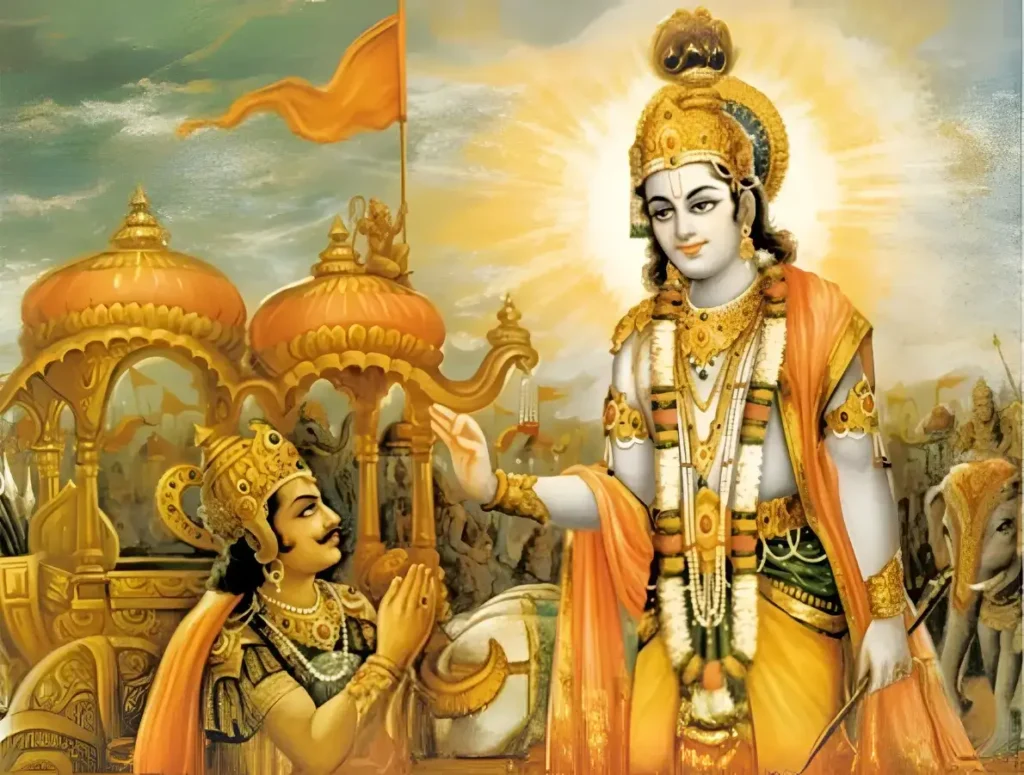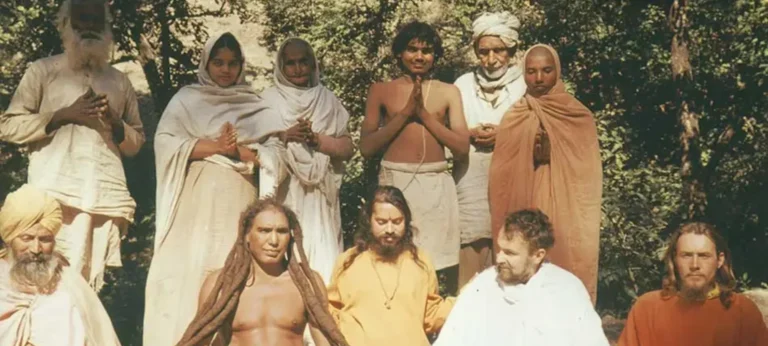Please Like the Blog and Share it for Maximum Reach
Table of Contents
Jnana Karma Yoga: Core Paths
- Path of Karma explained
- Role of Jnana in Karma Sannyasa
- Gunas and Maya as binding forces
- Jnana Yoga as identity with Brahman
- Selfless Karma vs egoistic action
- The final union with the Divine
The words Jnana and Karma in the Gita
The Gita uses many Vedic terms. Unless one recognizes and understands the spirit that these terms represent, one can never translate the Bhagavad Gita into a workable manual for handling life. The Gita frequently uses the words Jnana (ज्ञान) and Karma (कर्म) throughout the 700 verses of the scripture. These terms signify the very crux of Gita’s teachings.
The problem arises, when people casually say Jnana or Karma, making these words a part of the daily colloquial. In the Gita, when the Lord uses the term Karma alone, one should not confuse it with Karma Yoga (कर्म योग). Similarly, Jnana and Jnana Yoga (ज्ञान योग) mean two different concepts.
Scriptures recommend Jnana and Karma Marga
According to the Gita, one should only perform actions in accordance with the Vedic scriptures. Rightly so, Gita discusses the path of Karma, Jnana, and Bhakti in conjunction with Yoga. The Scriptures give two legitimate paths to follow, so as to benefit through the mode of goodness. The Scriptures recommend the Jnana Marga (Path of Knowledge) as well as the Karma Marga (Path of Action). Path of Action does not oppose the Path of Knowledge.
Renunciation of Karma not recommended
According to the Path of Action, the Gita recognizes the performance of action as Sadhana (साधना) or genuine spiritual practice (Chapter 6, Verse25 ). The Gita proclaims the renunciation of action to be a great hindrance or divergence (Chapter 3, verse 4), from the mode of goodness. In verses 47 to 51 of Chapter 2, verse 19 of Chapter 3, and verse 42 of Chapter 6, the Lord commands Arjuna to perform an action.
He advises Arjuna to follow the Path of Karma (Karma Yoga and not just Karma). In Chapter 3, verse 28 and Chapter 5, Verses 8, 9, and 13 the Lord explains about Knowledge-based actions. He advises as to how one should perform actions through the lens of Jnana or from the point of view of Pure Knowledge, Higher Intelligence. Higher Intelligence can only be awakened by surrendering at the feet of a genuine Guru who breathes every word of the Gita and keeps Satya or Truth as his fundamental working principle.
Gita does not recommend Motives (selfish or self-centred)
These discussions make it clear and evident that if one performs actions with interested motives, then the words of the scripture do not apply.
Neither the Path of Knowledge nor the Path of Action approves of interested motives, or the mind being driven by the whims and fancies of the mind subjugated by the six vices of Lust, Anger, Greed, Envy, Illusion and Self-Pride.

In the same breath, the Lord points out that men working with interested motives are people with a poor fund of intelligence. These explanations of the Lord refer to Chapter 2, Verse 42 to 44 and 49; Chapter 7, Verse 20 to 23; Chapter 9, Verse 20, 21 and 23, 24.
7/8 Questions from Sanatana Dharma
The scores generated in this Quiz may or may not be absolute. There may be right or wrong answers to each Question. A percentage towards 100 indicates that you are more aligned to the overall subject matter.
Meaning of Jnana Yoga
The Gita also does not use Jnana in the sense of Jnana Yoga, the Path of Knowledge alone. Jnana Yoga signifies Self-Realization (आत्मबोध), which is the culmination of all spiritual knowledge.
The Path of Knowledge, as well as the Path of Action, go hand-in-hand. Only Actions performed for the higher good, getting beyond the petty demands of the mind and senses work in alignment with Jnana. Such actions commensurate with the elements of Jnana Yoga, release the bondage of the spirit.
Such actions also culminate in the attainment of real knowledge or the Realization of Truth. Verse 24 and the latter half of Verse 25 of Chapter 4 speak of Jnana Yoga. Verses 36 to 39 of the same Chapter refer to Jnana as Self-realization.
Sincerity of Intention shall trigger Knowledge or Action
Scriptural Interpretation cannot be according to one’s convenience. We have to interpret the Scriptures in consonance with the intended context. Only sincerity and a true spirit of knowledge in all humility shall enable the understanding of the context.
Depending on the qualities of the individual, one should take up either the path of Knowledge or the path of Action. We will find it interesting to look into the highlights of the two paths.
Gunas or our inherent qualitative attributes
The Gita declares that all objects of the world are illusory or unreal like water seen in a mirage or like the world painted inside a dream. Thus all actions proceeding from the mind, senses, and the body are nothing but a movement within the Gunas (गुण). The Gunas are born of Maya (माया), Nature (प्रकृति), in the shape of the senses, etc. The Gunas move in front of us in the shape of sense-objects (इन्द्रिय-विषय).
These trap us and keep us engaged in them without break. Thus Nature is Maya which keeps us bound to the Gunas or qualities are represented by the sense objects in the form of the objects of the world.
Relinquishing Doership through the Path of Knowledge
Once the practitioner grasps this knowledge, the follower of the Path of Knowledge, no longer claims the doership of actions. Verse 8-9 of Chapter 5 reveals this. The practitioner ceases to recognize the existence of any other entity other than God (Chapter 13, verse 30).
He remains constantly established in identity with the all-pervading Supreme Spirit or God, who is the condensed pure form of Truth, Consciousness, and Bliss (सत-चित-आनंद). The Path of Knowledge unfurls in this manner. We know this as Jnana Yoga or Karma Sannyasa (कर्म-सन्यास).
Karma and Yamuna river analogy
At the beginning, while describing the union of Karma, Jnana and Bhakti Yoga,
Tulsidasji says-
राम भक्ति जहँ सुरसरि धारा | सरसई ब्रह्म बिचार प्रचारा ||
बिधि निषेधमय कलि मॉल हरनी | करम कथा रबिनंदनि बरनी ||
rāma bhakti jaha surasari dhārā | sarasaī brahma bicāra pracārā ||
bidhi niṣedhamaya kali maal haranī | karama kathā rabinaṃdani baranī ||
Karma or Purushartha can be compared to the Yamuna river.
The Yamuna river is vast. Being vast it flows into the Ganga tributary and finally through the Ganges unites with the ocean. What is the significance of this lengthy process? Karma (action) should be like the flowing river. The river promptly executes her duty, she performs social service. She provides her clean waters, for irrigation of the fields, human consumption and various social activities. She spreads her purity.
Humans should perform their Karma, just as a river selflessly bestows her clean waters and serves mankind. Now, what should be the foundation or source of such Karma? Karma is the Yamuna river and Yamuna is the daughter of Surya deva, the god of progress and higher ideals. Hence one’s action must emerge from morality, brilliance and right intent.
River is a high class social worker. But, she behaves in a strange manner. She flows into the sea which is abundant with water. She should instead revive the dry parched deserts. It would be the greatest service. But the river behaves indifferently. You can keep pleading all day before her, but she won’t change her path or even halt.
Even on merging in the Ganga, her flow wouldn’t abate. Someone asked the river- “Why do you waste your waters by merging in the ocean? The ocean is so full of water. What is your role then?” The river replied- “You can use me as you please, but until I merge into the ocean, I can’t attain completeness.”
सरिता जल जलनिधि महुँ जाई | होइ अचल जिमि जिव हरि पाई ||
saritā jala jalanidhi mahu jāī | hoi acala jimi jiva hari pāī ||
This means that unless the action oriented man surrenders himself unto Shri Rama he can’t experience gratitude, he can’t experience wholeness.
The Karma Yogi shouldn’t proceed towards the dry desert. He should not believe that it is only through social acts can he attain the highest. Finally the individual has to surrender unto the Lord. Only then, can he experience blessedness in life.
Someone questioned the river- “When you remained as a separate entity, as a river your waters were sweet and fresh, useful for all human activities, but now by merging into the salty waters of the ocean, you are rendered useless.”
The river gave an intelligent reply- “If you give it a serious thought, as long as I existed as an individual body and served society, my individualistic ego maintained itself, as this is Ganga water, and this is Yamuna water.
But now on merging into the ocean and vaporized as rain in the heavy clouds, my water still drizzles, but nobody calls it Gangaajal or Yamuna Jal.” So, as long as one’s petty ego binds, however well-equipped and virtuous one may be, he can’t taste the totality of life.
Please Like the Blog and Share it for Maximum Reach











